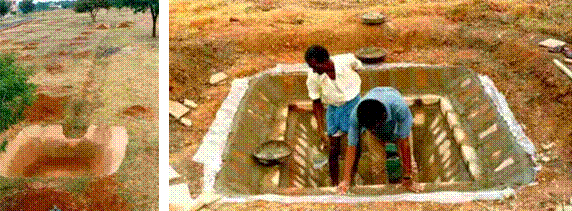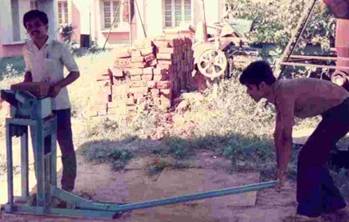Lining Technology
Polythene sheet for field channel lining:

1 |
Function |
: |
To avoid the seepage loss in field conveyance channel |
2 |
Seepage quantity |
: |
10 -15 % seepage loss in 150m length for medium textured soils
30-40 % in light textured soils and larger channels |
3 |
Materials required |
: |
Black polythene sheet 100 micron thickness (0.1mm)
Soil cover thickness of 15cm
Cost is Rs. 15per meter length of normal irrigated channels by the source of wells
20-30 % cheaper than conventional lining materials |
4 |
Optimum lining length for field channels (Periyar Vaigai Command) |
: |
For maximum net benefit all channel reaches upto a command area of 4.5 ha are to be lined.
For BC ratio = 1, all channel reaches upto a command area of 3.5 ha may be lined. |
5 |
Salient features |
: |
|
6 |
Laying technique |
: |
A minimum of 15cm thick soil should be dug out from the bottom of existing earthen channel all along its length. Before spreading the polythene sheet, small stones and pebbles that are found in the channel bed and sides should be removed. Then the polythene sheet should be cut wide enough to cover bottom and sides of the channel with free ends of about 15cm on both sides of the channel. Then the polythene sheet is spread out along the channel length. After the polythene sheet is laid, it is completely covered by the earth previously dug up from the channel. This soil cover keeps the polythene sheet safe from being damaged by direct sunlight due to light induced chemical reactions. This also avoids the mechanical damage that may occur due human and animal crossing of the channel. |
Lining of Farm ponds / Dug out ponds

1. |
Function |
: |
To minimise the seepage and percolation loss in rain water storage dug out ponds |
2. |
Technology options |
: |
Polythene lining (250mm thickness) overlaid by soil cover / stabilized soil tiles of 2.5 cm thickness
In situ soil stabilization with soil lime mixture (5:1) with a compaction technique for 15cm thickness
Clay lining with puddling techniques which needs animal plastering. |
3. |
Cost |
: |
30-40% cheaper in (a) and (b) than conventional lining |
Stabilised Soil Blocks

1. |
Function |
: |
It is an alternate construction material for the high cost and energy consuming burnt bricks for use in cattle sheds, farm godowns, lining etc. |
2. |
Materials required |
: |
Cement or lime - 6% of the weight of the soil.
Red soil ( without organic matter content)
Water – 12 to 18% by weight of soil. |
3. |
General information |
: |
The soil prepared by breaking bigger clods and sieve through 6 mm sieve. Suitable quantity of admixtures (cement or lime) are added and mixed well. Add water so that the soil when formed into balls at the palm does not break. Soil filled in the mould and pressed by two persons. After removing the lock, the lever is again pressed to eject the block out. |
4. |
Cost |
: |
60 % of cost of burnt bricks. (Rs. 2.50/- per block having the size 2.8 times of the burnt brick) |
5. |
Salient features |
: |
-
Size of block 30.5x14.4x10 cm.
-
The stabilized blocks require 28 days of curing for soil cement blocks.
-
The compressive strength at 28 days of curing comes to 30 to 45 kg/cm2.
-
For lime soil blocks compressive strength is 25 to 30 kg/cm2.
-
Has less water absorption: 15 to 18 % by weight.
-
Has good erosion resistance.
-
Weight 7.5 to 8.0 kg.
-
Adopted also as thin tiles of various sizes for covering polythene sheet lining and like conventional brick with cement mortar 1:5.
-
Labour saving to a tune of 20 %.
|
|

